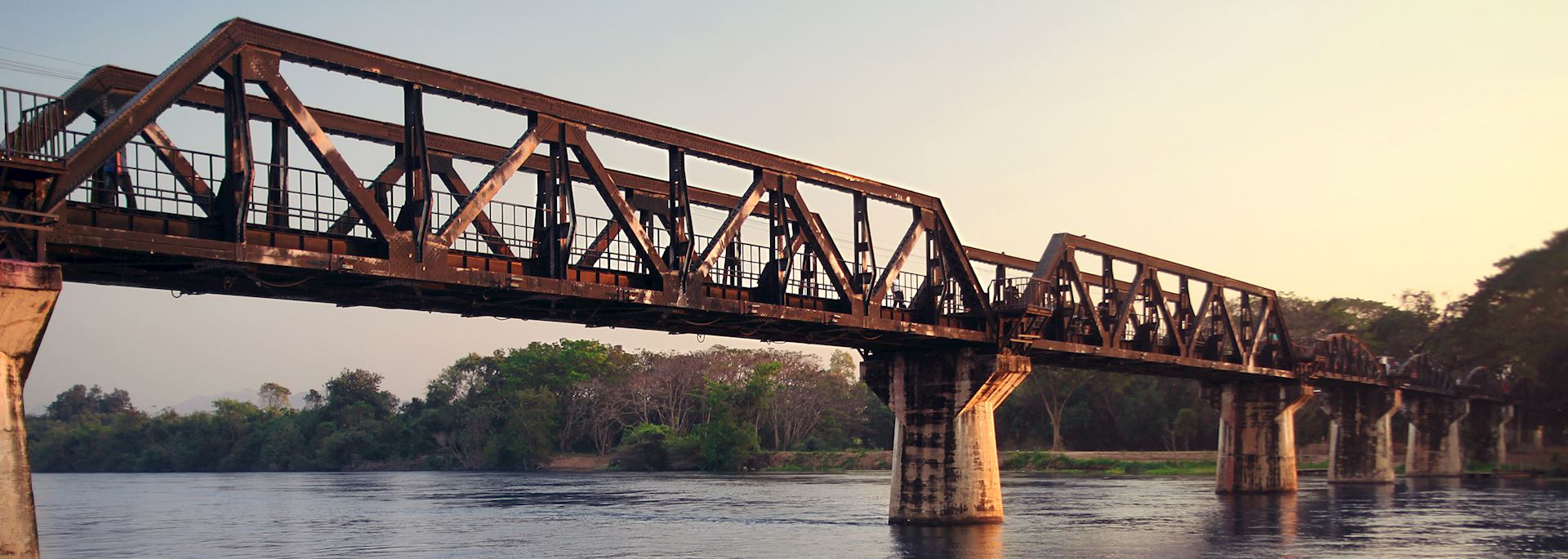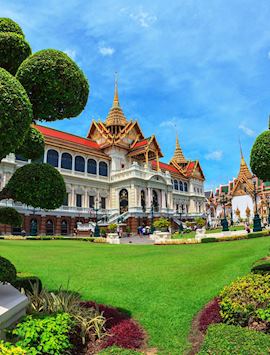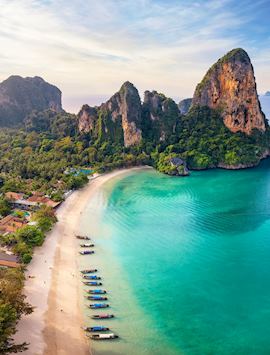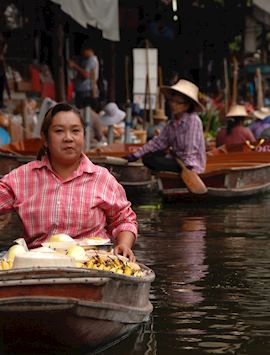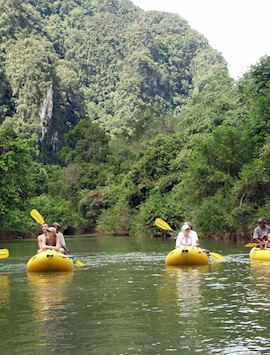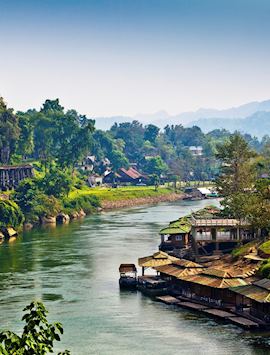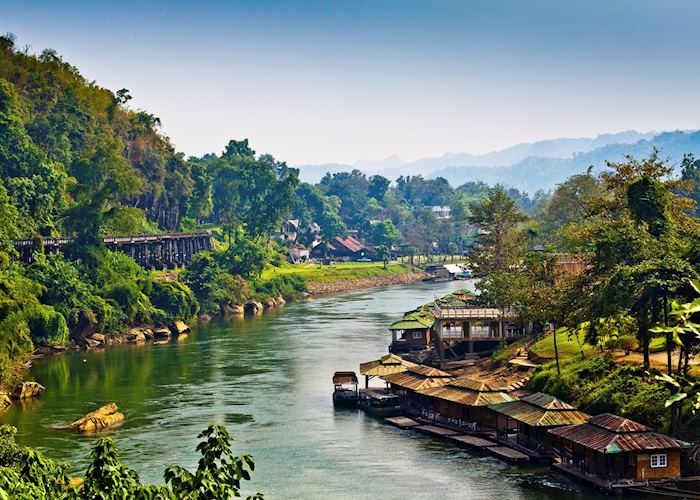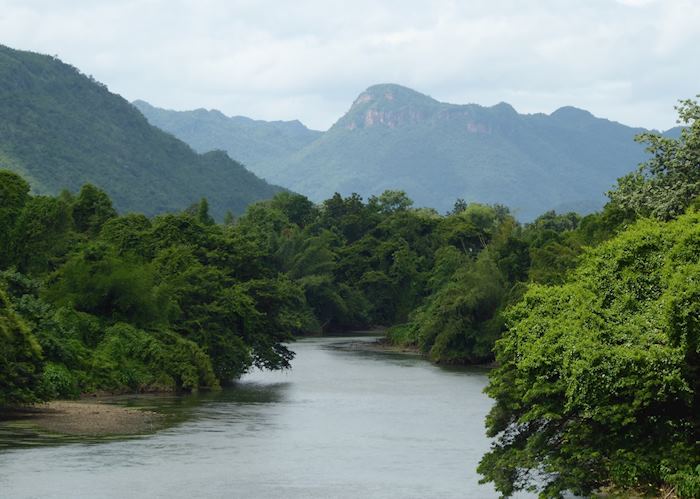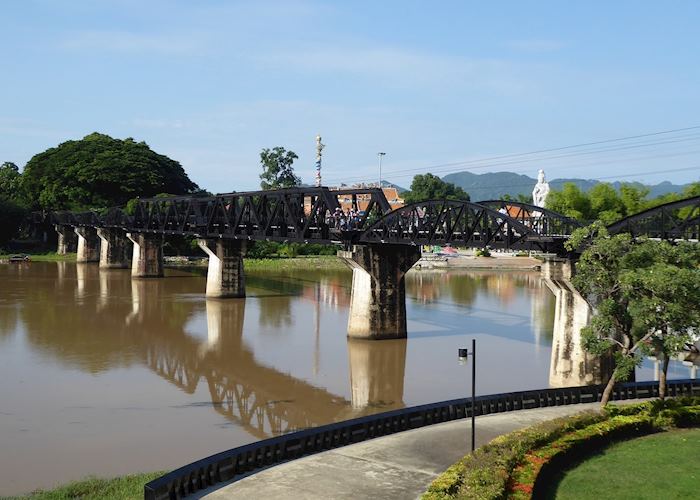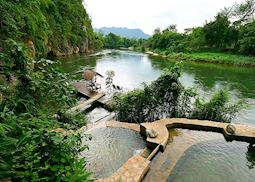Jump to:
Since the publication of Pierre Boulle’s 1952 novel, The Bridge on the River Kwai, the riverside city of Kanchanaburi has become synonymous with the prefabricated metal bridge that spans the Kwai’s turquoise waters. The book highlights the city’s position on the ‘Death Railway,’ a rail route from Thailand to Myanmar, orchestrated by Japanese forces using Allied prisoners of war (POWs) and Asian laborers.
Kanchanaburi has now become a place of memorial, with museums, war cemeteries, statues and an opportunity to ride the route itself — but, it’s also bloomed into a busy city, with riverside restaurants, markets and shops. And, that turquoise water leads to the waterfalls and jungle trails of Erawan National Park.
 The Thailand-Burma Railway Centre, an interactive museum dedicated to preserving the history of the ‘Death Railway’, is an ideal first stop. This small but carefully curated museum has a good collection of images (taking photos of the railway was quickly banned by the Japanese once working conditions deteriorated) which are useful for understanding the context of the modern city before you begin exploring.
The Thailand-Burma Railway Centre, an interactive museum dedicated to preserving the history of the ‘Death Railway’, is an ideal first stop. This small but carefully curated museum has a good collection of images (taking photos of the railway was quickly banned by the Japanese once working conditions deteriorated) which are useful for understanding the context of the modern city before you begin exploring.
The railway has been restored and still runs a few trains a day, crossing the bridge and the Tha Kilen Viaduct, a slightly perilous-looking wooden bridge that traverses the cliff edge. You’ll get views right across the river to the villages and farms below, as well as passing a number of former POW camps along the route.
You can also take a cruise along the river, heading under the bridge itself, where you’ll see the remains of the temporary wooden bridge that was first built by POWs in 1943. Continue upstream and the city gives way to rural farmsteads and overhanging jungle foliage.
Hellfire Pass
The deadliest part of the 415 km (258 mile) railway was the Konyu Cutting, a 600 m (1,968 ft) section of almost impenetrable rock which was hand-chiseled by hundreds of POWs working 18-hour shifts.
It’s located 80 km (50 miles) northwest of Kanchanaburi and has a dedicated memorial museum complete with an audio tour that includes first-person accounts from survivors.
You can follow an hour-long circular walking route that takes you out to the cutting itself. Descending a long staircase, you’ll reach a series of memorials and sections of railway track. Look carefully at the rock and you’ll see hundreds of thousands of individual chisel marks.
Erawan National Park
About an hour’s drive north of Kanchanaburi is Erawan National Park’s calling card, the Erawan Falls. Split over seven levels, the water falls into a series of aquamarine pools that are so ideal for swimming, it’s hard to believe this isn’t a man-made leisure resort. You’re shaded by the surrounding greenery and if you stand still long enough, you might feel the tickle of fish on your toes.
The national park is a base for outdoor activities: you can kayak, canoe or river raft the waterways, and cycle or trek through the forest. Trails aren’t well marked, and river conditions vary dramatically depending on rainfall, so you’re best to opt for a guided experience.
Best time to visit Kanchanaburi
It’s possible to visit Kanchanaburi year-round, but the best time of year is from late October to February, when the temperatures are comfortably warm and there’s little rain. From March the temperatures begin to rise, hitting 104°F (40°C) in April.
who's been there

Start planning your tailor-made trip to Kanchanaburi & The River Kwai by contacting one of our Thailand specialists
-
617-223-4521617-223-4125
- Make an inquiry
Suggested itineraries featuring Kanchanaburi & The River Kwai
Our itineraries will give you suggestions for what is possible when you travel in Kanchanaburi & The River Kwai, and they showcase routes we know work particularly well. Treat them as inspiration, because your trip will be created uniquely by one of our specialists.
Places near Kanchanaburi & The River Kwai
- Amphawa 50 miles away
- Bangkok 69 miles away
- Ayutthaya 74 miles away
- Khao Yai National Park 137 miles away
- Koh Samet 165 miles away
- Koh Kood 263 miles away
- Koh Tao 273 miles away
- Koh Phangan 300 miles away
Photos of Kanchanaburi & The River Kwai
Accommodation choices for Kanchanaburi & The River Kwai
We've selected a range of accommodation options for when you visit Kanchanaburi & The River Kwai. Our choices usually come recommended for their character, facilities and service or location. Our specialists always aim to suggest properties that match your preferences.
-
![Natural spring pool at the Hintok River Camp]()
Hintok River Camp
Kanchanaburi & The River Kwai -
![The Float House, Kanchanaburi]()
The FloatHouse River Kwai
Kanchanaburi & The River Kwai -
![Garden View Cottages, Oriental Kwai Resort]()
Oriental Kwai Resort
Kanchanaburi & The River Kwai -
![U Inchantree]()
U Inchantree Kanchanaburi
Kanchanaburi & The River Kwai -
![X2 Xcape River Kwai Grounds]()
Xcape River Kwai
Kanchanaburi & The River Kwai
Ideas for experiencing Kanchanaburi & The River Kwai
Our specialists seek out authentic ways to get to know the places that could feature in your trip. These activities reflect some of the experiences they've most enjoyed while visiting Kanchanaburi & The River Kwai, and which use the best local guides.
-
Adventure day in rural Kanchanaburi ![River Kwai, Kanchanaburi]()
Adventure day in rural Kanchanaburi
Adventure day in rural Kanchanaburi
Surrounded by forested peaks, you’ll cycle through Kanchanaburi’s countryside, before drifting along the River Kwai in a kayak or on a bamboo raft. Along the way, your private guide will give you insights into the local culture.
View details
